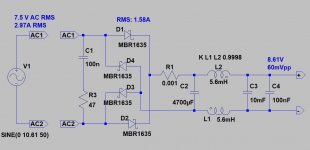I'm doing up a CLCLC filter chain 20uf - 15H - 40uf - 15H - 100uf. I recall seeing an article way back where the chokes are bolted together and maybe wired in anti-phase to obtain some humbucking. Does anyone have the reference to that construction technique or that old article?
It's worth it, if you use its in signal path, where induced or radiated disturbance occurs.chokes are bolted together and maybe wired in anti-phase to obtain some humbucking.
It's cancel common mode disturbances.
In PSU the CMC (Common Mode Choke) structure (one core, two coils wired in opposite direction in both -hot, cold- wire path) is useful to cancel common mode interference (going from mains).

It could work, but the only way to make it work is a reality test: there are too many "soft" parameters at play.I'm doing up a CLCLC filter chain 20uf - 15H - 40uf - 15H - 100uf. I recall seeing an article way back where the chokes are bolted together and maybe wired in anti-phase to obtain some humbucking. Does anyone have the reference to that construction technique or that old article?
Basically, you need a reasonably accurate model of your final build. You load it nominally, and monitor the ripple output.
You then try to find the best phase configuration (not too difficult, it is binary) and once you get it, you can begin to tweak the orientation/distance to optimize the rejection.
This needs to be done in the real environment, because everything magnetic present will influence the result: the chassis, obviously, but also screws and other hardware.
The optimal compensation will only work at one frequency: you will generally opt for 2*Fmains, but higher harmonics might end up reinforced. Tradeoffs, tradeoffs ....
Worth noting: CMC's are wired so as to cancel the inductance when seen from a differential POV. They are thus useless for filtering purposes, except for their meagre residual leakage and series resistance.
It would be tempting to use them in the opposite direction (inductance*4 instead of ~0), but they only withstand tens of mA at most under those conditions.
The humbucking scheme relies on a weak coupling (k<<1) that depends on all the rest of the circuit. A CMC typically has a k~=1, but some models have a deliberately low coupling, to also work as a differential choke (but k would still be much too high to work in realistic humbucking situations)
It would be tempting to use them in the opposite direction (inductance*4 instead of ~0), but they only withstand tens of mA at most under those conditions.
The humbucking scheme relies on a weak coupling (k<<1) that depends on all the rest of the circuit. A CMC typically has a k~=1, but some models have a deliberately low coupling, to also work as a differential choke (but k would still be much too high to work in realistic humbucking situations)
Thanks Elvee,
I remember a few things about the article, it would have to be something experimented with I guess. I remember the author bolting the identical open-bracket-two-hole chokes together probably rotating one of them to be anti-phase. That might be the extent of the construction technique, although the article probably did have some measurements and theory in it. Wish I could find it. I guess I can just try that and probe around with the scope to see if it works.
I remember a few things about the article, it would have to be something experimented with I guess. I remember the author bolting the identical open-bracket-two-hole chokes together probably rotating one of them to be anti-phase. That might be the extent of the construction technique, although the article probably did have some measurements and theory in it. Wish I could find it. I guess I can just try that and probe around with the scope to see if it works.